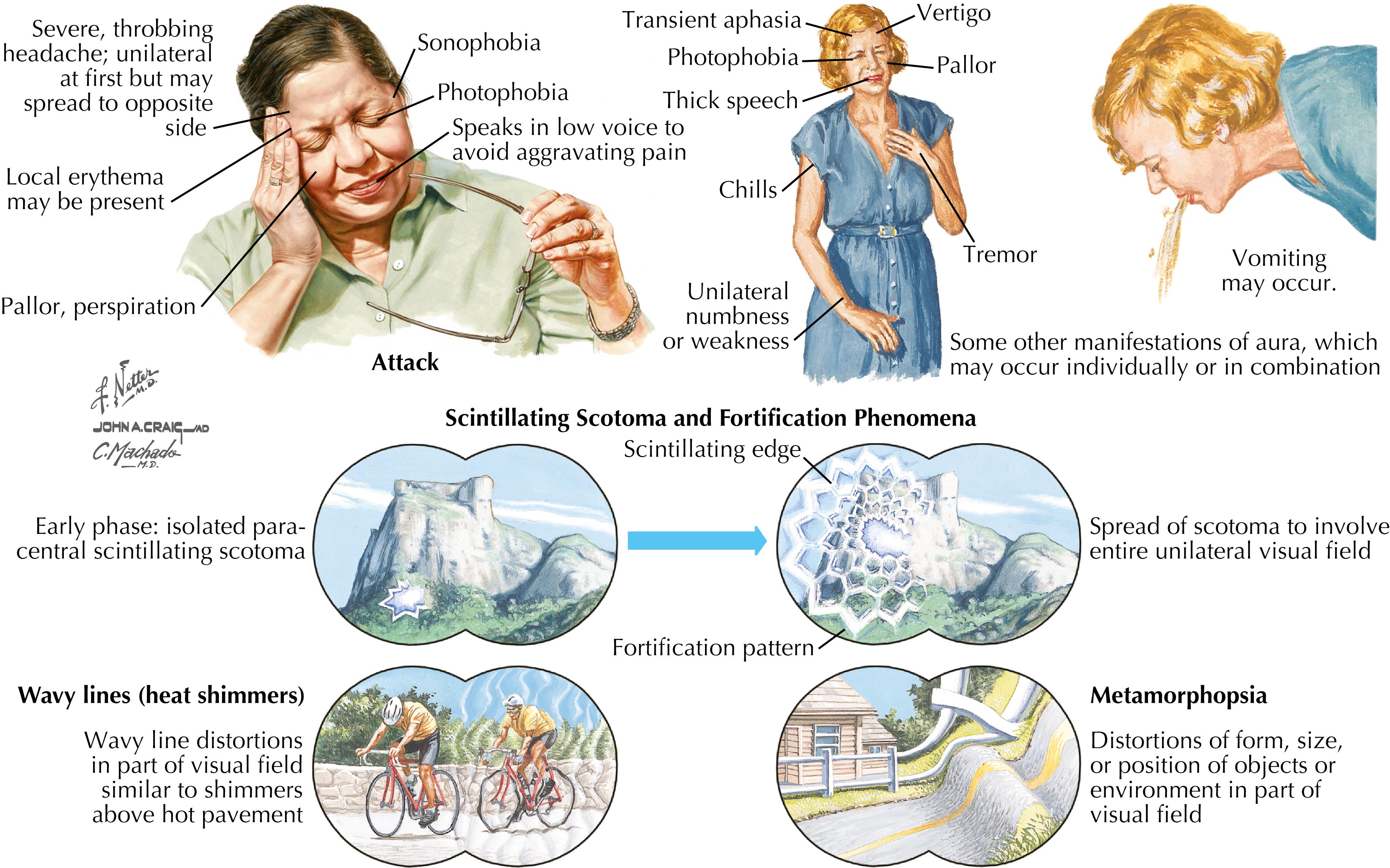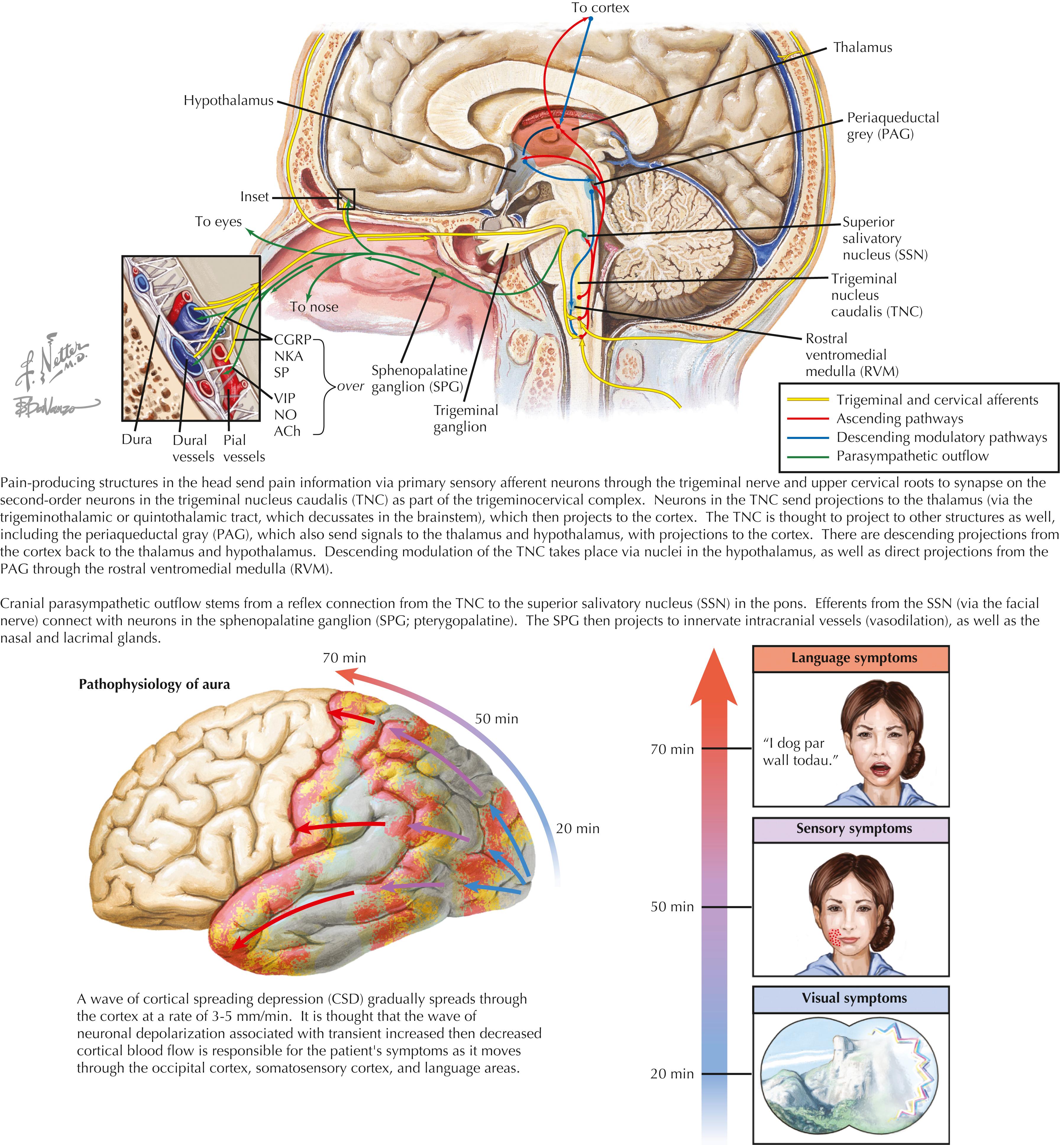Physical Address
304 North Cardinal St.
Dorchester Center, MA 02124
Headache is one of the most common disorders and symptoms reported to primary care, the emergency department, and team physicians.
Complaints of headache account for 1%–4% of primary care office and emergency department visits.
In the general population, the prevalence of headache in a 1-year period is >90% and the lifetime prevalence is 93%–99%.
Headaches are one of the most commonly reported pain complaints among children and adolescents.
In a population study of adolescents aged 11–21 years, >90% had experienced headaches, regardless of the type, over 1 year.
Among children aged 4–17 years in the United States, 6.7% had frequent headache pain over a 12-month period.
Various studies on athletes have shown a headache prevalence of 35%–50% related to participation in their sport.
The exact cause of many headaches is a source of much debate and likely differs for each specific type of headache. Physiologic changes in the head and brain that consist of, but are not limited to, changes in neurotransmitter regulation, vascular dilation and constriction, and cranial nerve irritation that cause activation of pain signals are all contributors to the development of headache. Cyclical hormonal changes and genetic predisposition are also thought to play an important role.
Tension-type headache (TTH), migraine, and cluster headaches combine to make up >90% of headaches experienced by the general population.
Adults mostly experience TTHs, whereas children are more likely to have migraine headaches.
Among children aged 3–18 years who visit pediatric neurologic clinics, vascular/migrainous headaches account for 52%, chronic headaches/TTHs for 21%, and unclassified headaches for 19%. Remainders are mixed tension-migraine, psychogenic, or posttraumatic.
Of headache-caused emergency department visits:
Migraine and TTHs account for 25%–55% of visits.
Headache associated with systemic illness accounts for 33%–39% of visits.
Headache caused by a serious neurologic condition (subarachnoid hemorrhage, intracranial mass, meningitis, or hemorrhage) accounts for 1%–16% of visits.
In 1988, the International Headache Society (IHS) created its first classification of headache disorders. This International Classification of Headache Disorders (ICHD) has subsequently been updated and revised twice, with finalization of the third version (ICHD-3) occurring in 2018.
Headache has many causes. The IHS classification gives a physician a logical approach to make a rapid and accurate differential diagnosis.
Headache disorders are classified as primary, secondary, or those caused by cranial neuralgias.
Primary headaches are those that have no underlying cause; there are three main types: migraine headache, TTH, and cluster headache (trigeminal autonomic cephalalgias).
Secondary headaches are those that may be attributed to certain underlying pathologic conditions (i.e., infectious, neoplastic, vascular, psychiatric, traumatic, drug-induced, or homeostatic changes).
Cranial neuralgia headaches are those that are initiated by compression, distortion, or irritation of specific cranial nerves and subsequently cause pain in the area that those nerves innervate.
The athletic population suffers from the same headache disorders as the general population but may also have a predisposition to suffer from other headache disorders and subtypes because of the effects of exercise and because of participation in their specific sports.
Sports-/exercise-related primary headaches are exercise-/effort-induced migraine and primary exertional headaches.
Sports-/exercise-related secondary headaches are acute and chronic posttraumatic headache (PTH), cervicogenic headache, high-altitude headache, and diving headache.
Sports-/exercise-related cranial neuralgia headaches are external compression headache and cold-stimulus headache.
Like all other medical evaluations, the assessment of headache begins with a thorough history and physical examination. Most patients will have a completely normal general physical and neurologic examination, so obtaining a detailed history is critical. After history and physical examination have been completed, a further investigation may be warranted, depending on the history and physical findings. This investigation may include laboratory workup, imaging, and/or diagnostic procedures.
When was the first onset of headache?
What is the frequency?
Where is the location, and is there any radiation of pain?
What is the character of the pain (dull, throbbing, sharp)?
What is the intensity of the pain?
Are there any associated symptoms?
Nausea/vomiting
Photophobia/phonophobia
Confusion
Blurry vision
Gait disturbances
Were any medications taken?
Are there any alleviating or exacerbating factors?
Is there a prior history of headache?
Is there a family history of headache?
Has there been a change in the headache characteristics (if prior history is positive)?
Is there a history of other medical issues?
What medications is the athlete taking?
Assess for level of consciousness, orientation, alertness, mini-mental status, and overall affect.
Check vital signs to rule out hypertension.
Evaluate head, eyes, ears, nose, and throat to assess for papilledema. Check for central nervous system abnormalities, including cranial nerve testing, ptosis, pupil reactivity, and head trauma.
Conduct musculoskeletal evaluation to assess for nuchal rigidity, temporomandibular joint problems, cervical spine range of motion, areas of scalp tenderness, and neck tenderness.
Conduct neurologic examination to assess for motor, sensory, and reflex response; also include evaluation of gait.
Check for evidence of systemic illness (assess abnormalities in the cardiovascular, respiratory, and gastrointestinal [GI] systems).
Laboratory evaluation: To rule out metabolic issues. Laboratory examinations that may aid in diagnosis are erythrocyte sedimentation rate, complete blood count, liver function tests, thyroid function tests, antinuclear antibodies, antiphospholipid antibodies, and drug screening. Appropriate tests must be conducted as indicated by the history and physical examination.
Imaging tests: Possibilities include cervical spine films, computed tomography (CT) (with or without contrast), magnetic resonance imaging (MRI), electroencephalogram (EEG), and magnetic resonance (MR) angiography. Selection of tests should be individualized.
Cervical spine radiography (flexion/extension views) in patients with trauma/neck pain, possible fracture, and instability.
CT scan with contrast for patients with new-onset exertional headache.
Some experts do not advocate CT unless neurologic examination is abnormal.
May not be helpful for suspected posterior fossa lesions
CT better for acute bleeding and bony fractures; detects surgical lesions as well as MRI scan
MRI has greater tissue contrast resolution than CT.
Better to perform MRI >48 hours after trauma and in patients with arteriovenous malformations (AVMs) or tumor
Study of choice when looking for lesions in the posterior fossa
Less radiation exposure compared with CT
According to the Quality Standards Subcommittee of the American Academy of Neurology, routine use of brain imaging is not warranted for adults with recurrent headaches that have been defined as migraines with no recent change in pattern, no history of seizure, and no other focal neurologic signs or symptoms.
Diagnostic procedure: Lumbar puncture (LP) to rule out subarachnoid hemorrhage from aneurysm; detects minor leaks, which occur in 39% of patients who later have ruptures. CT scans are negative in 55% of patients with minor leaks.
Consider the same diagnostic evaluation in athletes as in nonathletes, except in cases of trauma with an increased risk of intracranial bleed.
Workup should be complete when diagnosis is in question. This may include, but is not limited to, evaluation for drug abuse, hypertension, vascular lesions, neoplasms, intracranial bleeding, and psychiatric issues.
Be cognizant of “red flags” within the history or physical examination that should prompt further neurologic evaluation in the form of either imaging or other diagnostic procedures ( Box 39.1 ).
Headache onset after the age of 50 years
Sudden onset of severe headache
Change in headache pattern
Headache associated with systemic illness and fever
Headache associated with neck stiffness
Headache with focal neurologic deficits
Presence of papilledema
Headache in the setting of moderate/severe trauma
Alteration of consciousness or amnesia
Early morning nausea and vomiting without headache
Occurrence of seizure(s) after headache
See Table 39.1 .
| Migraine | Cluster | Tension-Type | |
|---|---|---|---|
| Onset | Peaks in adolescence | 30´ s or 40´ s | Variable; ≥20´ s |
| Frequency | 1–2 attacks/mo, often with menses | ≥1 attacks/day for 6–8 wk | Episodic: <15 days/mo Chronic: >15 days/mo |
| Location | Unilateral more common than bilateral; frontotemporal or orbital | 100% unilateral Generally orbitotemporal |
Bifrontal, bioccipital, neck |
| Quality | Throbbing or intense pressure | Nonthrobbing, penetrating, boring | Squeezing, pressing, aching |
| Duration | 4–72 hr, usually 12–24 hr | 30 min–2 hr, usually 45–90 min | Episodic: several hours Chronic: all day |
| Prodrome | Changes in mood, energy, appetite | May include brief, mild burning in eye and internal nares | None |
| Aura | Up to 60 min, usually 20 min; “often” visual | None | None |
| Associated Symptoms | Nausea, vomiting, photophobia | Ipsilateral ptosis-miosis, conjunctival injection, tearing, stuffed and running nose | Episodic: loss of appetite, light or sound sensitivity Chronic: light or sound sensitivity, nausea |
| Behavior | Go to dark, quiet room | Frenetic pacing, rocking | Generally not affected or mild decrease in function |
Definition: Migraine is a chronic, idiopathic neurologic disorder characterized by episodic headaches of high intensity that may be preceded by, accompanied with, or followed by other associated symptoms ( Figs. 39.1 and 39.2 ).


Associated symptoms
Premonitory (prodrome) symptoms: Occur hours up to 1–2 days before development of migraine headache. These symptoms are often thought of as a warning of an impending migraine.
Fatigue
Difficulty concentrating
Yawning
Change in appetite
Change in sleep patterns
Change in mood
Aura: A set of reversible focal neurologic symptoms that occur at the beginning of a migraine headache or just before its onset. Auras typically last for <60 minutes. Visual symptoms are most common.
Visual changes (scintillating scotoma, visual field deficits, and blurry vision)
Sensory disturbances (pins and needles sensation and numbness)
Speech disturbances (dysphasia)
Motor deficits (rare)
Resolution (postdrome) symptoms: These are symptoms that follow the headache and may include certain premonitory symptoms.
Exhaustion
Exhilaration
Depression
Nausea
Scalp tenderness
Migraine headache is divided into two major subtypes by the IHS.
Migraine without aura
Migraine with aura (10%–15% of migraines)
Migraine headaches are typically unilateral but can be bilateral. Bilateral migraine is more likely to occur in children/adolescents than adults. They also tend to have a pulsating nature; moderate-to-severe intensity; exacerbation by activity; and an association with nausea, vomiting, photophobia, and phonophobia.
IHS diagnostic criteria for migraine are listed in Box 39.2 .
At least five attacks fulfilling criteria B–D
Headaches lasting for 4–72 hours
Headache has at least two of the following characteristics:
unilateral location
pulsating quality
moderate or severe pain intensity
aggravated by physical activity
During headache, at least one of the following is present:
nausea and/or vomiting
photophobia and phonophobia
Cannot be attributed to another disorder
Typical age of onset is in adolescence.
Eighteen percent of women and 6% of men report headaches that meet the definition of migraine. The female-to-male ratio is 3:1.
A survey of 791 male and female National Collegiate Athletic Association (NCAA) Division I basketball players showed a total prevalence rate of 2.9% (0.9% of males, 4.4% of females).
Seventy percent of females who suffer from migraines note a relationship between their menstrual cycles and migraine attacks.
Migraine without aura: highest incidence during first 3 days of menses
Severe, debilitating forms of migraine include status migrainous, in which migraine lasts for >72 hours, and chronic migraine, in which migraines occur for ≥15 days per month.
Common migraine triggers include aspartame, caffeine (use or withdrawal), estrogens, monosodium glutamate, nicotine, nitrates, progesterone, alcohol, cheese, chocolate, menstruation, missed meals, perfume, red grapes, sleep (too much or too little), stress, changes in environment/weather, and exercise.
Become a Clinical Tree membership for Full access and enjoy Unlimited articles
If you are a member. Log in here